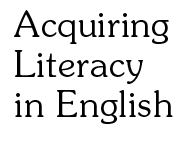Acquiring Literacy in English:
Crosslinguistic, Intralinguistic, and Developmental Factors
Phonological Awareness Test / Habilidad Fonológica
Author and Date
Lisa M. Lopez, Patton Tabors, and Mariela Páez, formerly of the Harvard Graduate School of Education, and Center for Applied Linguistics. 2002.
Purpose
The Phonological Awareness Test and Habilidad Fonológica are parallel instruments designed to investigate children's phonological awareness in English and Spanish, respectively. The tests were developed for the research study Early Childhood Study of Language and Literacy Development of Spanish-speaking Children, subproject 1 of Acquiring Literacy in English: Crosslinguistic, Intralinguistic, and Developmental Factors.
Age or Grade of Examinees
The instruments were developed to be used with students in pre-school through second grade.
Description
Each instrument consists of five subtests.
1. Rhyme Recognition/Rimas: Each of these consists of two practice items followed by six test items. The child is shown a prompt picture and choice pictures and given the name of each item depicted. The child is then asked to choose the picture whose name rhymes with the name of the item in the prompt picture. The child chooses between two pictures for test items 1 through 3, and among four pictures for test items 4 through 6.
Examples:
Test |
Child Sees |
Prompt |
Target |
|
|
|
|
|
|
|
|
2. Rhyme Production/ Producción de Rimas: Each of these consists of two practice items and four test items. The child is asked to produce a rhyme for a given word. Credit is given if the word the child provides is a rhyme, regardless of whether it is a real word or not.
Examples:
Test |
Child Sees |
Prompt |
Target |
|
|
|
|
|
|
|
|
3. Initial Phonemes/Fonema Inicial: In these tasks, the child is asked to match pictures of words with the appropriate initial sound.
Examples:
Test |
Child Sees |
Prompt |
Target |
|
|
|
|
|
|
|
|
4. Sentence Segmenting/Segmentación de Oraciones: Each of these consists of two practice items and five test items. The child is provided with a set of colorful tiles to use in this task. The researcher reads a sentence, and the child is asked to move one tile for each word in that sentence.
Examples:
Test |
Child Sees |
Prompt |
Target |
|
|
|
|
|
|
|
|
5. Syllable Segmenting/Segmentación de Sílabas: In these tasks, the researcher says a word and the child is asked to move one tile for each syllable in that word.
Examples:
Test |
Child Sees |
Prompt |
Target |
|
|
|
|
|
|
|
|
Administration
Each test is individually administered by a trained native speaker of the appropriate language. Each instrument takes approximately 10-15 minutes to administer.
Scoring and Interpretation
The tests are scored dichotomously, “1” for a correct response and “0” for an incorrect response. Only the test items are scored; the practice items are not.
Reliability and Validity
Phonological Awareness Test: Rasch analysis yielded a reliability coefficient of .68 for the full test.
Habilidad Fonolόgica: Rasch analysis yielded a reliability coefficient of .59 for the full test.
Validation data are pending.
Sources
The Phonological Awareness Test and Habilidad Fonolόgica were based on previous (unpublished) work by Lisa M. Lόpez, when she was at the University of Miami; David K. Dickinson, when he was at the Education Development Center; Andrea Rolla San Francisco, at the Harvard Graduate School of Education; and Adele Miccio, at Pennsylvania State University.
Availability
The Phonological Awareness Test and Habilidad Fonolόgica are available from the Center for Applied Linguistics. To request a copy, complete and submit the Application Form for Use of ALE Researcher-developed Assessment Instruments, available in Microsoft Word and Adobe PDF format.
Citation
Researchers using the Phonological Awareness Test and Habilidad Fonolόgica should cite them as follows:
Harvard University and Center for Applied Linguistics. (2002). Phonological Awareness Test. Washington, DC: Center for Applied Linguistics.
Harvard University and Center for Applied Linguistics. (2002). Habilidad Fonolόgica. Washington, DC: Center for Applied Linguistics.

